Nutrient Recycling
Need to Know
- Define the term: nutrient recycling by organisms
- Outline and draw the carbon cycle
- Outline and draw the nitrogen cycle
Nutrient Recycling
There is a limited amount of nutrients in Earth e.g. you are probably aware of the water cycle - where water is constantly being recycled in nature. There are similar cycles for all nutrients
When plants and animals die, their nutrient content is not wasted
Bacteria and fungi decompose the remains and release the nutrients back into the abiotic environment (i.e. into the soil, nearby water and air)
These nutrients are then taken up by other plants and used to make new organic material
This material is passed on down the food chains and is reused by all the chain members
When death occurs for these members, the nutrients are again returned to the abiotic environment and the cycling of nutrients continues in this circular way
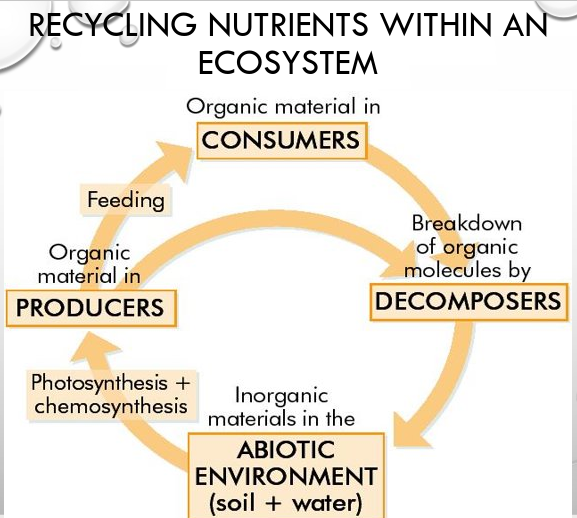
This ensures that there is no real long term drain on the Earth’s nutrients, despite millions of years of plant and animal activity
The Carbon Cycle
Carbon forms part of all organic nutrients - carbohydrates, fats and proteins
Carbon Dioxide is removed from the environment by photosynthesis in plants, and under certain conditions, over long periods of time, some of these plants may form fossil fuels such as coal, oil, peat, and natural gas
Carbon dioxide is returned to the environment by:
- Respiration in plants, animals & micro-organisms
- Decay caused by micro-organisms
- Combustion i.e. burning fossil fuels
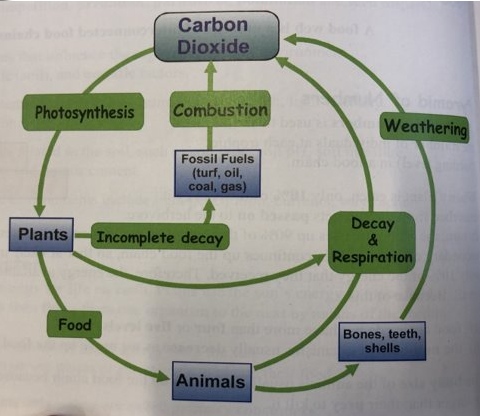
The Nitrogen Cycle
All organisms need nitrogen for protein, DNA and RNA manufacture
78% of the Earth’s atmosphere is nitrogen gas, but it cannot be used in this form by plants and animals
Nitrogen gas must first be ‘fixed’, i.e. changed to a suitable form (ammonia or nitrate) before it can be used
Nitrogen Fixation
- Nitrogen-Fixing bacteria in the soil convert N₂ gas in the air into ammonia (NH₃). This accounts for the majority of all N₂ fixation
- Lightening storms and fuel burning in car engines produce nitrates, which are washed by rain into the soil water
- Nitrates are absorbed by plant roots and converted to plant protein
The Nitrogen Cycle
- Plant proteins are passed along food chains to become animal protein
- When organisms die, their proteins are converted to ammonia by bacterial decomposition
- Nitrifying bacteria in the soil then convert ammonia (NH3) into nitrites (NO22-) then into nitrates (NO3-)
-
Nitrates can be absorbed by other plants to continue the cycle
-
Denitrifying bacteria convert soil nitrates into N2 gas
This is a loss of N2 from the cycle
Only happens in anaerobic conditions (when O2 levels are low) – due to flooding or accumulation of sewage
- Nitrate also enters the cycle through the addition of nitrogen rich fertilisers to the soil – made industrially from nitrogen gas
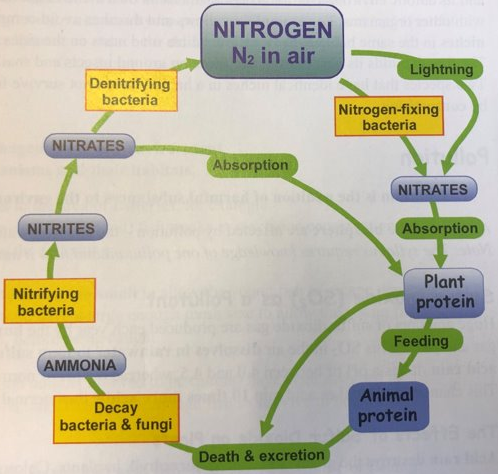
Summary of Nitrogen Cycle
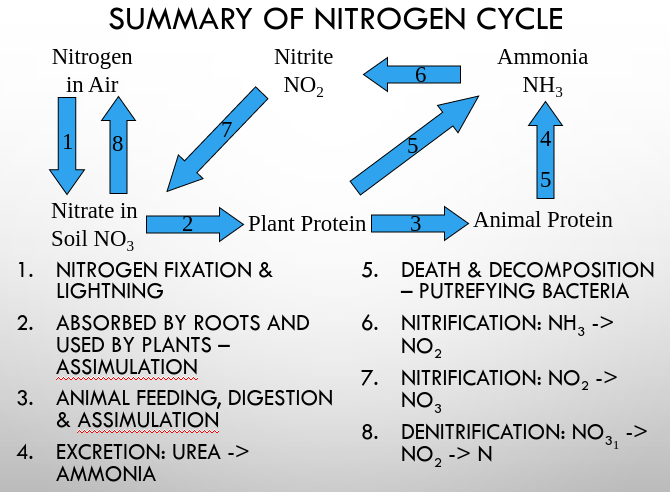
- Nitrogen (N₂) in the air is converted to Nitrates (NO⁻ ₃) by Nitrogen Fixing Bacteria / lightning and are absorbed by plants + eaten by animals
- Animals excrete Ammonia (NH₃) and release it when they die
- Nitrification - Bacteria turn Ammonia (NH₃) into (nitrites (NO⁻ ₂) and then turn into) Nitrates (NO⁻ ₃)
- Denitrifcation - Bacteria turn Nitrates (NO⁻ ₃) into Atmospheric Nitrogen (N₂)
Human Impact on an Ecosystem 1: Pollution
Need to Know
- Define the term: Pollution
- State areas affected by pollution
- State mechanisms to control pollution
- Explain the difference between the terms: pollutant and pollution
- Discuss the ecological impact of one human activity
Human Impact on Ecosystem
We are going to look at 3 ways that humans affect ecosystems:
- Pollution
- Conservation
- Waste Management
Note: from Syllabus Clarifications – Pollution must be related to habitat studied
Pollution
Pollution is any human addition (contamination) to a habitat or the environment that leaves it less able to sustain life
It is the most harmful human impact and affects air, fresh water, sea, soil and land
Chemicals of human origin that harm the environment are called **pollutants**
CO2 released during respiration is not a pollutant
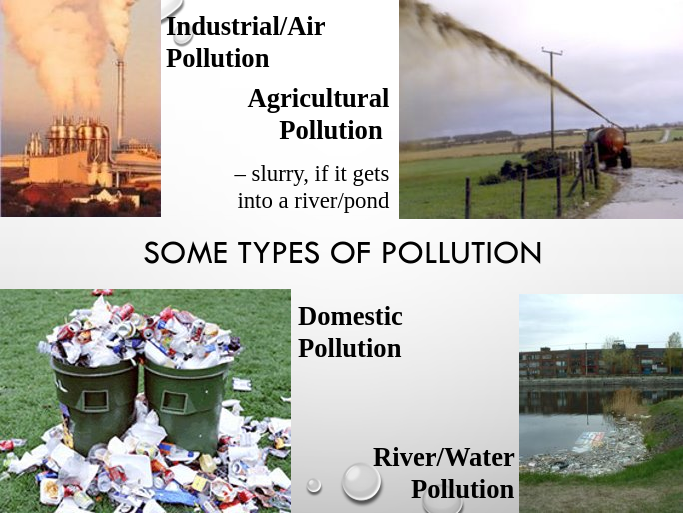
From the Syllabus & Guidelines
The Syllabus states: “Study the effects of any one pollutant” The Guidelines for Teachers states: “Give the effects of one pollutant from any of the following areas: domestic, agricultural, industrial” and
“Give an example of one way in which pollution may be controlled in the selected area”
What follows is only a sample of the pollutants available
Effect of one pollutant from one area - Agricultural, Industrial or Domestic
| Area | Type | Source | Effect |
|---|---|---|---|
| Domestic | Plastic Bags | Shopping | Non-biodegradable, Suffocate small animals, Litter |
Control of Pollutants, in the selected area - Agricultural, Industrial or Domestic
| Area | Type | Control Measure |
|---|---|---|
| Domestic | Plastic bags | Bag tax/levy. Reuse/Recycle bags |
Human Impact on an Ecosystem 2: Conservation
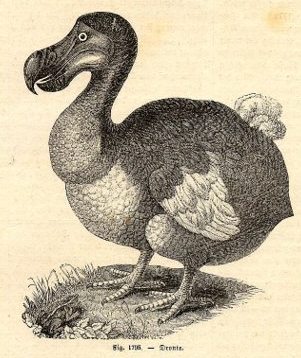
Have you seen one of these recently?
It is a Dodo and has been extinct since 1681
How did it happen?
What happened to the Dodo?
{Not examinable}
- In 1598 Portuguese and Dutch sailors were the first people to live on the island of Mauritius
- With them they brought pigs, dogs, rats and even monkeys
- They killed dodos for food and by 1681 (83 years later) they were extinct
A article on the Relationship of the Dodo Bird and the Calvaria Tree {Not examinable}
What is Conservation?
Conservation is the protection and wise management of natural resources, organisms and the environment
Benefits of Conservation
- Existing environments are maintained
- Endangered species are preserved for reproduction
- The balance of nature is maintained
- Pollution and its effects are reduced
One conservation practice from one of the following areas
| Area | Conservation Practice |
|---|---|
| Agriculture | Mixed farming, Crop rotation, Biological controls, Gene banks |
| Fisheries | Fishing Net size, Quotas, Re-stocking |
| Forestry | Re-planting, Broadleaf/conifer mix |
There is a need for continual monitoring of the environment to ensure its protection and the wise management of its natural resources
Agriculture
One conservation practice from one of the following areas is required:
- Mixed Farming
- Crop Rotation
- Biological Controls
- Gene Banks
Biological Controls
What are Biological Controls?
Biological Control is a method of controlling pests (including weeds) and diseases in agriculture that uses living organisms (predation, parasitism) rather than introduced chemicals
Conservation and Biological Controls
- Ladybird larva eating woolly apple aphids
Advantages:
- No chemical used
- No chemical residues left on plants
- No leaching of chemicals into soil or water courses

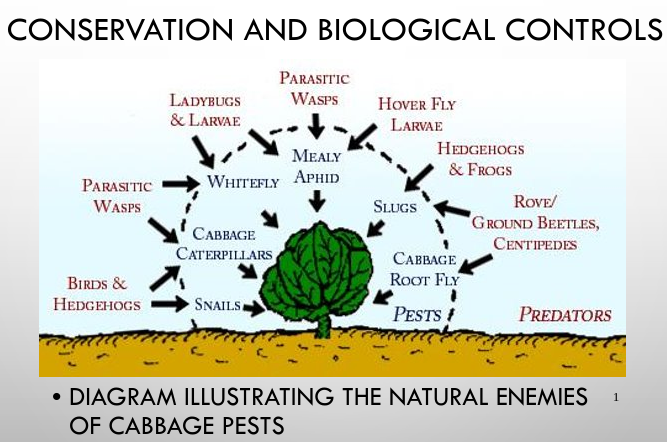
Human Impact on an Ecosystem 3: Waste Management
Need to Know
- State problems associated with waste management & disposal
- Explain the importance of waste minimisation
- Explain the role of microorganisms in waste management and pollution control
Waste Management
What is waste management?
Waste Management is the collection, transport, processing, recycling or disposal of waste materials, produced by human activity, in an effort to reduce their effect on human health or local aesthetics or amenity
It also tries to reduce waste materials’ effect on the natural world and the environment and to recover resources from them
Urban rubbish is mostly dust, dirt, hair, paper, food scraps, metal, glass and plastic
Traditional disposal has been to bury rubbish in landfill sites or incinerate
Landfill Operation
The area being filled has a rubberized landfill liner in place (exposed on the left in photo)
This prevents leaching materials migrating downward through the underlying rock
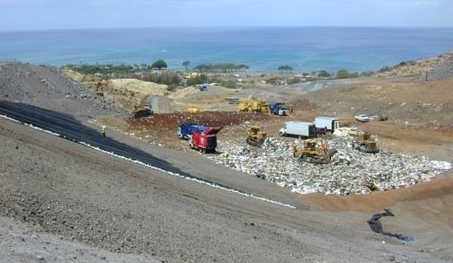
One of the following is necessary
Waste Management in:
Agriculture OR Fisheries OR Forestry
Waste Management in forestry
- Leaves from coniferous trees should not be allowed fall into rivers – make the water acidic
- Chemicals and fertilisers should not be allowed run off into waterways - algal blooms and eutrophication
- When trees are harvested only bare poles are removed so a lot of tree debris (called brash) and the stumps are left behind
Forestry Solutions
- Waste Management in the forestry sector is all based on recycling
- When the trees are harvested brash and the stumps are left behind
- The stumps are sprayed with a urea-type compound which speeds up the decomposition process
Problems with Waste Disposal
- Availability of suitable landfill sites
- The toxic or polluting content of fumes from incineration (CO2, other acidic oxides and dioxins – produced from burning plastic)
- Decaying waste produces methane gas which contributes to the “greenhouse gases”
Possible Solutions
- Lifestyle changes and education programmes for all ages are needed to alter the attitudes to littering and waste minimisation and disposal
- Use micro-organisms to degrade the rubbish and produce fuel pellets
- Biodegradable materials (e.g. paper bags) should be used in place of plastic ones
Suggestions for Waste Minimisation
- Reduce – use less, minimise waste
- Re-use – use again, without changing but maybe for a different purpose
- Recycle – change, recover some material and use again
Role of Micro-organisms in Waste Management
- Composting is an aerobic process during which micro-organisms decompose organic matter into (a stable substance called) compost which recycles all the nutrients required for plant growth
- Since it is aerobic the organic waste mixture must be turned and loosened to allow air into it
- This increases the size and number of air pores